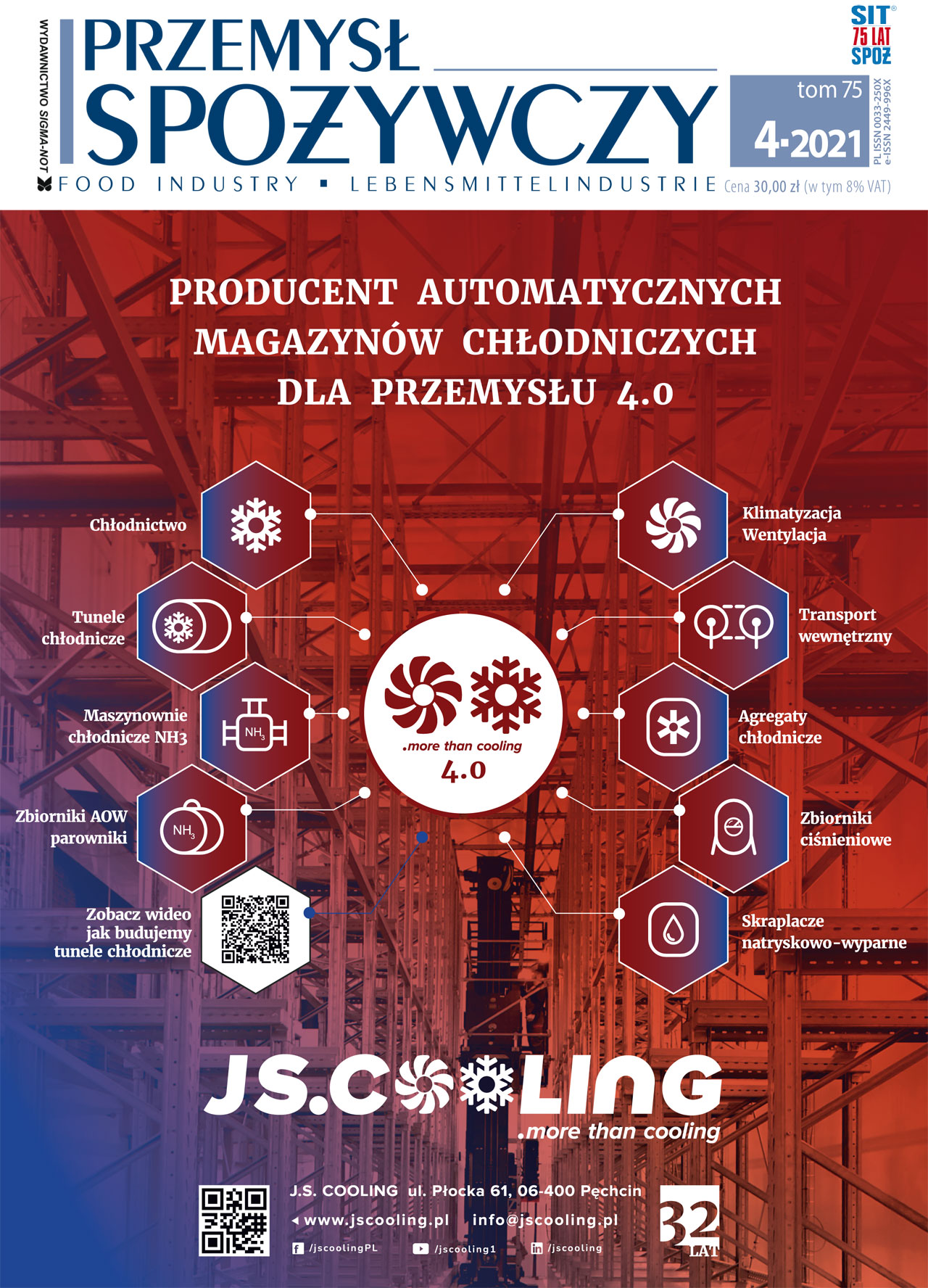ECONOMY
- 2 The Red Meat and Poultry Sector in Poland During The COVID-19 Coronavirus Pandemic – Robert Mroczek
The article presents an assessment of the domestic red meat and poultry sector in 2020, which was under the pressure from the spreading COVID-19 pandemic and its negative impact on the global economy. According to the forecast of IAFE-NRI, meat production in Poland amounted to approx. 5,200 thousand tonnes (in hot carcass weight) and was approx. 1% higher than in 2019. Pork and poultry meat production may have increased by about 1% each, while beef meat production decreased by about 1%. In 2020, despite the unfavourable external environment (including ASF), the economic and financial situation of meat industry enterprises in Poland improved. On the other hand, the economic and financial results of poultry industry companies worsened, which was influenced by the COVID-19 coronavirus pandemic and avian influenza, which stopped the sale of poultry meat to the HoReCa sector and hindered its export.
KEY WORDS: pandemic, meat production, meat industry, poultry industry
- 9 The Economic Consequences of Food Adulteration on The Polish Market – Stanisław Kowalczyk
Food and food trade are of exceptional interest to state and local government authorities, various national and international organizations, politicians, researchers, and above all, producers and consumers. This is a consequence of the fact that food belongs to exceptional goods, because it satisfies the basic human need – the need to satisfy hunger. Hence, it is exposed to various, not always fair, market practices. One of the main ones is food fraud, which has a direct impact on the economic security of consumers. The main goal of the research is to estimate the scale of food that does not meet the quality standards and the requirements of food law, in other words, the value of adulterated food on the Polish market in recent years. The study was conducted on the basis of the actual results of the control of the Agricultural and Food Quality Inspection, the leading and, since 2020, the only official food control institution in the area of food quality and economic safety (combating adulteration) in Poland. The study covers the period 2005-2019, i.e. the period after Poland’s accession to the EU structures.
KEY WORDS: food, globalization, food quality, food adulteration, consumers
LAW
- 16 Legislative Aspects Related to The Contamination of Foodstuffs with Elements Harmful to Health in The Light of The Work of The European Commission – Monika Mania, Małgorzata Rebeniak, Oksana Orshulayk, Ewelina Charos, Jacek Postupolski
The article presents the updates that have recently taken place in the European Union legislation regarding the maximum permisible levels of harmful elements to human health in foodstuffs. It is of particular importance to extend the requirements for cadmium and lead to foodstuffs for young children excluded from the scope of Regulation (EU) No 609/2013 of the European Parliament and of the Council, as well as to lower the requirements for lead in products intended for infants and young children. Another important issue is the significant reduction of the limits for cadmium in foodstuffs that contribute significantly to the intake of this toxic element in the diet, i.e. vegetables and vegetable products, cereals and cereal products, and fruits. Attention was also paid to the updated risk assessment for nickel in food and drinking water recently published by European Food Safety Authority (EFSA).
KEY WORDS: elements harmful to human health, foodstuffs, maximum permissible levels, legislation
- 22 Novel Food – Law and Practice from The Point of View of New Technologies and Innovations in The Food Industry – Paweł Mirosz
New technologies and innovations in the food chain determine the competitiveness of enterprises. EU law aims to stimulate their development while maintaining fair conditions of competition, protection of health and consumer interests, and environmental benefits. The above priorities are included, e.g. in the novel food regulation. The main feature of this diverse group of products is that it has not been widely consumed by people in the European Union before May 15, 1997. Food business operators are responsible for checking the status of the food they intend to place on the market. In case of doubt, the EU consultation procedure can be used. However, if we are dealing with a novel food, its placing on the EU market requires a formal assessment and authorization from the European Commission.
KEY WORDS: novel food, food law, risk assessment, European Commission
TECHNICS– TECHNOLOGY
- 27 High Hydrostatic Pressures as An Alternative Method of Food Preservation – Agnieszka Jackowska-Tracz
High hydrostatic pressure (HHP) technology is an alternative non-thermal method of food preservation. This method provides an adequate level of reduction of pathogenic microorganisms and food spoilage microorganisms, affecting the shelf life extension. Due to the diversity of microbiological effects, the food business operator should validate the intended application process. Validation is an element of the HACCP system’s activities and includes examining the effectiveness of planned solutions (technological parameters) concerning the product. It should be emphasized that HHP technology, like other food preservation methods, cannot be used in place of obligatory good hygiene practices that are prerequisite for the proper functioning of the food safety management system. HHP technology is also used to improve the organoleptic properties of food. It is an energy-efficient and environmentally friendly process.
KEY WORDS: HHP, pathogen inactivation, microbiological criteria, shelf life, organoleptic characteristics
- 33 Hydraulic Systems in Bakery Machines – Krzysztof Towarnicki
The following article describes the most common hydraulic systems in bakery machines. There are drive, transport and lubrication systems. Examples of hydraulic diagrams of drive systems were presented along with examples of machines in which they are used. The transport and lubrication systems are presented in a similar way. The basic element of the hydraulic system is the pump. Its main task is to transport liquids and generate pressure in positive displacement pumps designed for propulsion systems. The significant development of hydraulic systems results from the proliferation of electronic systems for controlling elements of the hydraulic system. Due to the increasing automation of technological processes in the bakery industry, one should expect an increasing share of hydraulic systems in the construction of bakery machines. This is due to the advantages of the hydraulic system, i.e. a wide range of speeds (linear or rotational) and power control of the receivers.
KEY WORDS: driveline, hydraulics, lubrication
FOOD-FEEDING
- 38 Analysis of The Gluten-Free Food Market and The Recognition of The System of Labeling with The Licensed Trademark of The Crossed Grain – Aleksandra Walma, Klaudia Kulik, Katarzyna Świąder, Joanna Rachtan-Janicka
Gluten-free foods are an essential part of therapy for people with celiac disease, gluten allergy, Dühring’s disease, and non-celiac gluten/wheat sensitivity, where the only treatment is strictly following a gluten-free diet. Along with the growing demand for gluten-free products, their market is dynamically changing, and the range is systematically expanding. To improve the identification of gluten-free food and reduce the risk of introducing gluten-containing products into the diet, the European Licensing System and the Crossed Grain trademark were introduced. The article presents a review and analysis of the Polish lists of gluten-free products developed by the Polish Association of People with Celiac disease and on a gluten-free diet, and discusses the results of surveys on the recognition and trust of consumers in the Cross-Grain trademark among people using a gluten-free diet. The obtained results indicate high consumer confidence in food labeled with the licensed sign of the Crossed Grain and the increasing share of these products in the market of all gluten-free food.
KEY WORDS: gluten, gluten free food, gluten free products, Crossed Grain trademark




